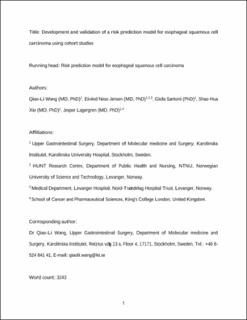| dc.contributor.author | Wang, Qiaoli | |
| dc.contributor.author | Ness-Jensen, Eivind | |
| dc.contributor.author | Santoni, Giola | |
| dc.contributor.author | Xie, Shaohua | |
| dc.contributor.author | Lagergren, Jesper | |
| dc.date.accessioned | 2022-02-22T16:05:16Z | |
| dc.date.available | 2022-02-22T16:05:16Z | |
| dc.date.created | 2022-01-07T08:27:00Z | |
| dc.date.issued | 2021 | |
| dc.identifier.citation | American Journal of Gastroenterology. 2021, 116 (4), 683-691. | en_US |
| dc.identifier.issn | 0002-9270 | |
| dc.identifier.uri | https://hdl.handle.net/11250/2980846 | |
| dc.description.abstract | INTRODUCTION:
Esophageal squamous cell carcinoma (ESCC) carries a poor prognosis, but earlier tumor detection would improve survival. We aimed to develop and externally validate a risk prediction model based on exposure to readily available risk factors to identify high-risk individuals of ESCC.
METHODS:
Competing risk regression modeling was used to develop a risk prediction model. Individuals' absolute risk of ESCC during follow-up was computed with the cumulative incidence function. We used prospectively collected data from the Nord-Trøndelag Health Study (HUNT) for model derivation and the UK Biobank cohort for validation. Candidate predictors were age, sex, tobacco smoking, alcohol consumption, body mass index (BMI), education, cohabitation, physical exercise, and employment. Model performance was validated internally and externally by evaluating model discrimination using the area under the receiver-operating characteristic curve (AUC) and model calibration.
RESULTS:
The developed risk prediction model included age, sex, smoking, alcohol, and BMI. The AUC for 5-year risk of ESCC was 0.76 (95% confidence interval [CI], 0.58–0.93) in the derivation cohort and 0.70 (95% CI, 0.64–0.75) in the validation cohort. The calibration showed close agreement between the predicted cumulative risk and observed probabilities of developing ESCC. Higher net benefit was observed when applying the risk prediction model than considering all participants as being at high risk, indicating good clinical usefulness. A web tool for risk calculation was developed: https://sites.google.com/view/escc-ugis-ki.
DISCUSSION:
This ESCC risk prediction model showed good discrimination and calibration and validated well in an independent cohort. This readily available model can help select high-risk individuals for preventive interventions. | |
| dc.language.iso | eng | en_US |
| dc.publisher | Lippincott, Williams & Wilkins | en_US |
| dc.title | Development and validation of a risk prediction model for esophageal squamous cell carcinoma using cohort studies | en_US |
| dc.type | Peer reviewed | en_US |
| dc.type | Journal article | en_US |
| dc.description.version | acceptedVersion | en_US |
| dc.rights.holder | This is the authors' accepted manuscript to an article published by Wolters Kluwer Health, Inc.. Locked until 1/4-2022 due to copyright restrictions. | en_US |
| dc.source.pagenumber | 683-691 | en_US |
| dc.source.volume | 116 | en_US |
| dc.source.journal | American Journal of Gastroenterology | en_US |
| dc.source.issue | 4 | en_US |
| dc.identifier.doi | 10.14309/ajg.0000000000001094 | |
| dc.identifier.cristin | 1976265 | |
| cristin.ispublished | true | |
| cristin.fulltext | postprint | |
| cristin.qualitycode | 1 | |
